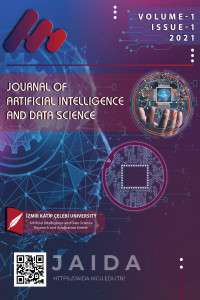Optimization of Process Parameters for Green Composites in Abrasive Water Jet Machining Process Using Neuro-Regression Analysis
Abstract
This study aims to develop a design procedure for optimizing the abrasive water jet machining (AWJM) process in green composites. Multiple non-linear neuro-regression analysis has been performed methodically to overcome insufficient approaches to modeling-design-optimizing green composites in AWJM. First, the model generation process is carried out according to three criteria: linearity, order, and functions used in the model. Next, R^2_training, R^2_testing, and R^2_validation values have been checked for the validity of the models. Then, the machining parameters have been optimized by applying a numerical non-linear global optimization algorithm, Simulated Annealing. Pressure within the pumping system (PwPS), stand-off distance (SoD), and nozzle speed (NS) are design variables; surface roughness (Ra) and process time (PT) are objective functions of introduced mathematical optimization problems. The numerical result shows that the optimum process parameters obtained are PwPS (150 MPa), SoD (3.5 mm), and NS (125 mm/min). This novel optimization approach is also feasible for another modeling design optimization problem. The proposed design can be used as a systematic framework for parameter optimization in environmentally conscious manufacturing processes.
References
- [1] B. Jagadish, S. Bhormik, A. Ray, “Prediction and optimization parameters of green composites in AWJM process using response surface methodology,” The International Journal of Advanced Manufacturing Technology, vol. 87, Nov., pp. 1359-1370, 2016.
- [2] P. Peng, D. She, “Isolation, structural characterization, and potential applications of hemicelluloses from bamboo: A Review,” Carbonhydrate Polymers, vol. 112, July, pp.701-720, 2014.
- [3] K. Oksman, J. F. Selin, Plastics and composites from polylactic acid, in Natural Fibers, Plastics and Composites. Boston, MA: Springer US, 2004.
- [4] A. Getu, O. Sahu, “Green composite material from agricultural waste,” International Journal of Agricultural Research and Reviews, vol. 2, no.5, June, pp. 56-62, 2014.
- [5] A. Sorgun, “Manufacturing and characterization of sandalwood filled polypropylene composite,” MSc. Thesis, pp. 1-35, 2019.
- [6] B. Gökdemir, “Investigation of usability of sugar beet pulp in biocomposite production, MSc. Thesis, pp. 14-49, 2020.
- [7] G. U. Raju, S. Kumarappa, V. N. Gaitonde, “Mechanical and physical characterization of agricultural waste reinforced polymer composites,” Journal of Materials and Environmental Science, vol. 3, no. 5, June, pp. 907-916, 2012.
- [8] F. C. Tsai, B. H. Yan, C. Y. Kuan, F. Y. Huang, “A Taguchi and experimental investigation into the optimal processing conditions for the abrasive jet polishing of SKD61 mold steel,” Int. J. of Machine Tools and Manuf., vol. 48, no. 7-8, June, pp. 932–945, 2008.
- [9] U. Caydas, A. Hasçalık, “A study on surface roughness in abrasive water jet machining process using artificial neural net-works and regression analysis method,” Journal of Materials Processing Technology, vol. 202, no. 1-3, June, pp. 574–582, 2008.
- [10] D. S. Srinivasu, N. R. Babu, “A neuro-genetic approach for selection of process parameters in abrasive waterjet cutting considering variation in diameter of focusing nozzle,” Applied Sofy Computing, vol. 8, no. 1, Jan., pp. 809–819, 2008.
- [11] A. M. Zain, H. Haron, S. Sharif, “Estimation of the minimum machining performance in the abrasive waterjet machining using integrated ANN-SA,” Expert Systems with Applications, vol. 38, no. 7, July, pp. 8316–8326, 2011.
- [12] A. M. Zain, H. Haron H, S. Sharif, “Optimization of process parameters in the abrasive waterjet machining using integrated SA–GA,” Applied Soft Computing, vol. 11, no. 8, Dec., pp. 5350–5359, 2011.
- [13] J. J. R. Jegarah, N. R. Babu, “A soft computing approach for controlling the quality of cut with abrasive waterjet cutting system experiencing orifice and focusing tube wear,” Journal of Materials Processing Technology, vol. 185, no. 1-3, April, pp. 217–227, 2007.
- [14] A. Iqbal, N. U. Dar, G. Hussain, “Optimization of abrasive water jet cutting of ductile materials,” Journal of Wuhan University of Technol Mater. Sci. Ed., vol. 26, no. 1, March, pp. 88–92, 2011.
- [15] V. Sharma, S. Chattopadhyaya, S. Hloch, “Multi response optimization of process parameters based on Taguchi-fuzzy model for coal cutting by water jet technology,” Int J Adv Manuf Technol, vol. 56, March, pp. 1019–1025, 2011.
- [16] Z. Yue, C. Huang, H. Zhu, J. Wang, P. Yao, Z. Liu, “Optimization of machining parameters in the abrasive waterjet turning of alumina ceramic based on the response surface methodology,” Int J Adv Manuf Technol, vol. 71, Feb., pp. 2107–2114, 2014.
- [17] H. S. Ergur, Y. Oysal, “Estimation of cutting speed in abrasive water jet using an adaptive wavelet neural network,” Journal of Intelligent Manufacturing, vol. 26, June, pp. 403–413, 2013.
- [18] İ. Polatoglu, L. Aydın, B. Ç. Nevruz, S. Ozer, “A Novel Approach for the Optimal Design of a Biosensor,” Analytical Letters, vol. 53, no. 9, Jan., pp. 1428-1445, 2020.
- [19] Jose, J. P.; Thomas, S.; Kuruvilla, J. ; Malhotra, S. K. ; Goda, K., & Sreekala, M. S. (2012). Advances in polymer composites: macro-and micro composites—state of the art, new challenges, and opportunities. Polymer Composites; Wiley: Weinheim, Germany, 1, 3-16.
- [20] Kumar, R., Jagtap, H. P., Rajak, D. K., & Bewoor, A. K. (2020). Traditional and Non-Traditional Optimization Techniques to Enhance Reliability in Process Industries. In AI Techniques for Reliability Prediction for Electronic Components (pp. 67-80). IGI Global.
Details
| Primary Language | English |
|---|---|
| Subjects | Artificial Intelligence |
| Journal Section | Research Articles |
| Authors | |
| Publication Date | August 30, 2021 |
| Submission Date | July 24, 2021 |
| Published in Issue | Year 2021 Volume: 1 Issue: 1 |
All articles published by JAIDA are licensed under a Creative Commons Attribution 4.0 International License.



